The Health Education Assets Library (HEAL) is a collection of over 22,000 freely available digital materials for health sciences education. The collection is now housed at the University of Utah J. Willard Marriott Digital Library.
| Title | Description | Subject | Collection | ||
|---|---|---|---|---|---|
| 76 |
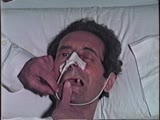 |
Cranial Nerve Exam: Abnormal Examples: Cranial Nerve 5 - Motor (x2) | The first patient shown has weakness of the pterygoids and the jaw deviates towards the side of the weakness. The second patient shown has a positive jaw jerk which indicates an upper motor lesion affecting the 5th cranial nerve. Video courtesy of Alejandro Stern, Stern Foundation. NeuroLogic Exam h... | Cranial Nerve Examination | NeuroLogic Exam: An Anatomical Approach |
| 77 |
 |
Cranial Nerve Exam: Abnormal Examples: Cranial Nerve 5 - Sensory | There is a sensory deficit for both light touch and pain on the left side of the face for all divisions of the 5th nerve. Note that the deficit is first recognized just to the left of the midline and not exactly at the midline. Patients with psychogenic sensory loss often identify the sensory change... | Cranial Nerve Examination | NeuroLogic Exam: An Anatomical Approach |
| 78 |
 |
Cranial Nerve Exam: Abnormal Examples: Cranial Nerve 5 - Sensory (x2) | There is a sensory deficit for both light touch and pain on the left side of the face for all divisions of the 5th nerve. Note that the deficit is first recognized just to the left of the midline and not exactly at the midline. Patients with psychogenic sensory loss often identify the sensory change... | Cranial Nerve Examination | NeuroLogic Exam: An Anatomical Approach |
| 79 |
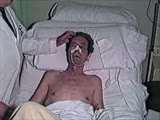 |
Cranial Nerve Exam: Abnormal Examples: Cranial Nerve 7 - Motor | The first patient has weakness of all the muscles of facial expression on the right side of the face indicating a lesion of the facial nucleus or the peripheral 7th nerve. The second patient has weakness of the lower half of his left face including the orbicularis oculi muscle but sparing the forehe... | NeuroLogic Exam: An Anatomical Approach | |
| 80 |
 |
Cranial Nerve Exam: Abnormal Examples: Cranial Nerve 7 - Motor (x2) | The first patient has weakness of all the muscles of facial expression on the right side of the face indicating a lesion of the facial nucleus or the peripheral 7th nerve. The second patient has weakness of the lower half of his left face including the orbicularis oculi muscle but sparing the forehe... | NeuroLogic Exam: An Anatomical Approach | |
| 81 |
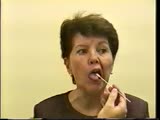 |
Cranial Nerve Exam: Abnormal Examples: Cranial Nerve 7 - Sensory, Taste | The patient has difficulty correctly identifying taste on the right side of the tongue indicating a lesion of the sensory limb of the 7th nerve. NeuroLogic Exam has been supported by a grant from the Slice of Life Development Fund at the University of Utah, the Department of Pediatrics and the Offic... | Cranial Nerve Examination | NeuroLogic Exam: An Anatomical Approach |
| 82 |
 |
Cranial Nerve Exam: Abnormal Examples: Cranial Nerve 7 - Sensory, Taste (x2) | The patient has difficulty correctly identifying taste on the right side of the tongue indicating a lesion of the sensory limb of the 7th nerve. NeuroLogic Exam has been supported by a grant from the Slice of Life Development Fund at the University of Utah, the Department of Pediatrics and the Offic... | Cranial Nerve Examination | NeuroLogic Exam: An Anatomical Approach |
| 83 |
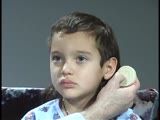 |
Cranial Nerve Exam: Abnormal Examples: Cranial Nerve 8 - Auditory Acuity, Weber & Rinne Tests | This patient has decreased hearing acuity of the right ear. The Weber test lateralizes to the right ear and bone conduction is greater than air conduction on the right. He has a conductive hearing loss. NeuroLogic Exam has been supported by a grant from the Slice of Life Development Fund at the Univ... | Cranial Nerve Examination; Weber Test; Rinne Test | NeuroLogic Exam: An Anatomical Approach |
| 84 |
 |
Cranial Nerve Exam: Abnormal Examples: Cranial Nerve 8 - Auditory Acuity, Weber & Rinne Tests (x2) | This patient has decreased hearing acuity of the right ear. The Weber test lateralizes to the right ear and bone conduction is greater than air conduction on the right. He has a conductive hearing loss. NeuroLogic Exam has been supported by a grant from the Slice of Life Development Fund at the Univ... | Cranial Nerve Examination; Weber Test; Rinne Test | NeuroLogic Exam: An Anatomical Approach |
| 85 |
 |
Cranial Nerve Exam: Abnormal Examples: Cranial Nerves 2 & 3 - Pupillary Light Reflex | The swinging flashlight test is used to show a relative afferent pupillary defect or a Marcus Gunn pupil of the left eye. The left eye has perceived less light stimulus (a defect in the sensory or afferent pathway) then the opposite eye so the pupil dilates with the same light stimulus that caused c... | Cranial Nerve Examination; Marcus Gunn Pupil | NeuroLogic Exam: An Anatomical Approach |
| 86 |
 |
Cranial Nerve Exam: Abnormal Examples: Cranial Nerves 2 & 3 - Pupillary Light Reflex (x2) | The swinging flashlight test is used to show a relative afferent pupillary defect or a Marcus Gunn pupil of the left eye. The left eye has perceived less light stimulus (a defect in the sensory or afferent pathway) then the opposite eye so the pupil dilates with the same light stimulus that caused c... | Cranial Nerve Examination; Marcus Gunn Pupil | NeuroLogic Exam: An Anatomical Approach |
| 87 |
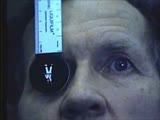 |
Cranial Nerve Exam: Abnormal Examples: Cranial Nerves 3, 4 & 6 - Ductions | Each eye is examined with the other covered (this is called ductions). The patient is unable to adduct either the left or the right eye. If you watch closely you can see nystagmus upon abduction of each eye. When both eyes are tested together (testing versions) you can see the bilateral adduction de... | Cranial Nerve Examination; Ductions | NeuroLogic Exam: An Anatomical Approach |
| 88 |
 |
Cranial Nerve Exam: Abnormal Examples: Cranial Nerves 3, 4 & 6 - Ductions (x2) | Each eye is examined with the other covered (this is called ductions). The patient is unable to adduct either the left or the right eye. If you watch closely you can see nystagmus upon abduction of each eye. When both eyes are tested together (testing versions) you can see the bilateral adduction de... | Cranial Nerve Examination; Ductions | NeuroLogic Exam: An Anatomical Approach |
| 89 |
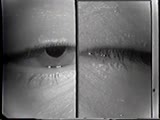 |
Cranial Nerve Exam: Abnormal Examples: Cranial Nerves 3, 4 & 6 - Inspection & Ocular Alignment | This patient with ocular myasthenia gravis has bilateral ptosis, left greater then right. There is also ocular misalignment because of weakness of the eye muscles especially of the left eye. Note the reflection of the light source doesn't fall on the same location of each eyeball. NeuroLogic Exam ha... | Cranial Nerve Examination | NeuroLogic Exam: An Anatomical Approach |
| 90 |
 |
Cranial Nerve Exam: Abnormal Examples: Cranial Nerves 3, 4 & 6 - Inspection & Ocular Alignment (x2) | This patient with ocular myasthenia gravis has bilateral ptosis, left greater then right. There is also ocular misalignment because of weakness of the eye muscles especially of the left eye. Note the reflection of the light source doesn't fall on the same location of each eyeball. NeuroLogic Exam ha... | Cranial Nerve Examination | NeuroLogic Exam: An Anatomical Approach |
| 91 |
 |
Cranial Nerve Exam: Abnormal Examples: Cranial Nerves 3, 4 & 6 - Versions | The first patient shown has incomplete abduction of her left eye from a 6th nerve palsy. The second patient has a left 3rd nerve palsy resulting in ptosis, dilated pupil, limited adduction, elevation, and depression of the left eye. NeuroLogic Exam has been supported by a grant from the Slice of Lif... | Cranial Nerve Examination | NeuroLogic Exam: An Anatomical Approach |
| 92 |
 |
Cranial Nerve Exam: Abnormal Examples: Cranial Nerves 3, 4 & 6 - Versions (x2) | The first patient shown has incomplete abduction of her left eye from a 6th nerve palsy. The second patient has a left 3rd nerve palsy resulting in ptosis, dilated pupil, limited adduction, elevation, and depression of the left eye. NeuroLogic Exam has been supported by a grant from the Slice of Lif... | Cranial Nerve Examination | NeuroLogic Exam: An Anatomical Approach |
| 93 |
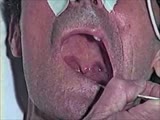 |
Cranial Nerve Exam: Abnormal Examples: Cranial Nerves 9 & 10 - Motor | When the patient says ah there is excessive nasal air escape. The palate elevates more on the left side and the uvula deviates toward the left side because the right side is weak. This patient has a deficit of the right 9th & 10th cranial nerves. Video courtesy of Alejandro Stern, Stern Foundation. ... | Cranial Nerve Examination | NeuroLogic Exam: An Anatomical Approach |
| 94 |
 |
Cranial Nerve Exam: Abnormal Examples: Cranial Nerves 9 & 10 - Motor | When the patient says ah there is excessive nasal air escape. The palate elevates more on the left side and the uvula deviates toward the left side because the right side is weak. This patient has a deficit of the right 9th & 10th cranial nerves. Video courtesy of Alejandro Stern, Stern Foundation. ... | Cranial Nerve Examination | NeuroLogic Exam: An Anatomical Approach |
| 95 |
 |
Cranial Nerve Exam: Abnormal Examples: Cranial Nerves 9 & 10 - Motor (x2) | When the patient says ah there is excessive nasal air escape. The palate elevates more on the left side and the uvula deviates toward the left side because the right side is weak. This patient has a deficit of the right 9th & 10th cranial nerves. Video courtesy of Alejandro Stern, Stern Foundation. ... | Cranial Nerve Examination | NeuroLogic Exam: An Anatomical Approach |
| 96 |
 |
Cranial Nerve Exam: Abnormal Examples: Cranial Nerves 9 & 10 - Motor (x2) | When the patient says ah there is excessive nasal air escape. The palate elevates more on the left side and the uvula deviates toward the left side because the right side is weak. This patient has a deficit of the right 9th & 10th cranial nerves. Video courtesy of Alejandro Stern, Stern Foundation. ... | Cranial Nerve Examination | NeuroLogic Exam: An Anatomical Approach |
| 97 |
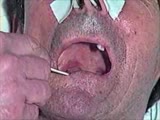 |
Cranial Nerve Exam: Abnormal Examples: Cranial Nerves 9 & 10 - Sensory & Motor: Gag Reflex | Using a tongue blade, the left side of the patient's palate is touched which results in a gag reflex with the left side of the palate elevating more then the right and the uvula deviating to the left consistent with a right CN 9 & 10 deficit. Video courtesy of Alejandro Stern, Stern Foundation. Neur... | Cranial Nerve Examination | NeuroLogic Exam: An Anatomical Approach |
| 98 |
 |
Cranial Nerve Exam: Abnormal Examples: Cranial Nerves 9 & 10 - Sensory & Motor: Gag Reflex (x2) | Using a tongue blade, the left side of the patient's palate is touched which results in a gag reflex with the left side of the palate elevating more then the right and the uvula deviating to the left consistent with a right CN 9 & 10 deficit. Video courtesy of Alejandro Stern, Stern Foundation. Neur... | Cranial Nerve Examination | NeuroLogic Exam: An Anatomical Approach |
| 99 |
 |
Cranial Nerve Exam: Abnormal Examples: Optokinetic Nystagmus | This patient has poor optokinetic nystagmus when the tape is moved to the right or left. The patient lacks the input from the parietal-occipital gaze centers to initiate smooth pursuit movements therefore her visual tracking of the objects on the tape is inconsistent and erratic. Patients who have a... | Cranial Nerve Examination | NeuroLogic Exam: An Anatomical Approach |
| 100 |
 |
Cranial Nerve Exam: Abnormal Examples: Optokinetic Nystagmus (x2) | This patient has poor optokinetic nystagmus when the tape is moved to the right or left. The patient lacks the input from the parietal-occipital gaze centers to initiate smooth pursuit movements therefore her visual tracking of the objects on the tape is inconsistent and erratic. Patients who have a... | Cranial Nerve Examination | NeuroLogic Exam: An Anatomical Approach |
